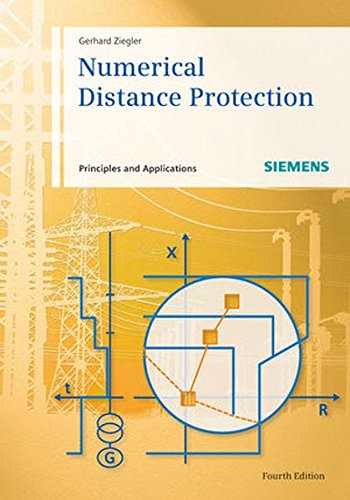(Ebook PDF) Numerical distance protection principles and application 4th Edition by Gerhard Ziegler ISBN 9783895786679 3895786675 full chapters
$50.00 Original price was: $50.00.$35.00Current price is: $35.00.
(Ebook PDF) Numerical distance protection principles and application 4th Edition by Gerhard Ziegler-Ebook PDF Instant Download/Delivery:9783895786679, 3895786675
Instant download Full Chapter of Numerical distance protection principles and application 4th Edition after payment

Product details:
ISBN 10:3895786675
ISBN 13:9783895786679
Author: Gerhard Ziegler
Distance protection provides the basis for network protection in transmission systems and meshed distribution systems. This book covers the fundamentals of distance protection and the special features of numerical technology. The emphasis is placed on the application of numerical distance relays in distribution and transmission systems.
This book is aimed at students and engineers who wish to familiarise themselves with the subject of power system protection, as well as the experienced user, entering the area of numerical distance protection. Furthermore it serves as a reference guide for solving application problems.
For this fourth edition all contents, especially the descriptions of numerical protection devices and the very useful appendix have been revised and updated.
Table of Contents:
- 1 Introduction
- 2 Definitions
- 3 Mode of Operation
- 3.1 Fundamentals of distance protection
- 3.1.1 Concept
- 3.1.2 Relay impedance (secondary impedance)
- 3.1.3 Impedance diagram
- 3.1.4 Distance measurement
- 3.1.5 Directional fault discrimination
- 3.1.6 Starting (fault detection)
- 3.1.7 Distance zones (steps)
- 3.1.8 Zone- and timer-control
- 3.1.9 Switched and non-switched distance protection
- 3.1.10 Distance protection with signalling channels
- 3.1.11 Power swing blocking, power swing tripping (out of step protection)
- 3.1.12 Distance protection with automatic reclosure
- 3.1.13 Distance to fault locator
- 3.1.14 Grading chart
- 3.2 Numerical distance measurement
- 3.2.1 Definition of the fault loop
- 3.2.2 Determination of the loop impedance
- 3.2.3 Numerical impedance computation
- 3.3 Numerical direction determination (polarisation)
- 3.3.1 Direction determination with fault loop voltage (self polarisation)
- 3.3.2 Direction determination with healthy phase voltages (cross-polarisation)
- 3.3.3 Directional characteristic in the impedance plane
- 3.3.4 Selection of the cross polarisation voltage
- 3.3.5 Influence of load transfer
- 3.3.6 Implementation of voltage-memory(-ies)
- 3.3.7 Adaptive directional determination
- 3.4 Circular characteristics with numerical technology
- 3.4.1 MHO-circle
- 3.4.2 Polarised MHO-characteristic
- 3.4.3 Load influence on polarised MHO-circles
- 3.4.4 MHO-circle with voltage memory
- 3.5 Distance measurement, Influencing quantities
- 3.5.1 Fault resistance
- 3.5.2 Intermediate infeeds
- 3.5.3 Parallel lines
- 3.5.4 Distance protection for transformers
- 3.5.5 Non-symmetry of the line
- 3.5.6 Distance protection of HV cables
- 3.5.7 Series-compensation
- 4 Device design
- 4.1 Intelligent electronic devices (IEDs)
- 4.2 Mechanical design
- 4.3 Relay Communications
- 4.4 Integrated functions
- 4.5 Relay terminal connections
- 4.6 Relay operation
- 5 Application
- 5.1 General aspects
- 5.1.1 Application criteria
- 5.1.2 Shortest line length
- 5.1.3 Tripping time
- 5.1.4 Teleprotection, choice of technique
- 5.1.5 Instrument transformer requirements
- 5.2 Distance protection in the distribution system
- 5.2.1 General
- 5.2.2 Distance protection in isolated or compensated systems
- 5.2.3 Distance protection in distribution networks with low impedance star-point earthing
- 5.2.4 Distance protection in industrial networks
- 5.3 Distance protection in transmission networks
- 5.3.1 Generals aspects
- 5.3.2 Protection concepts
- 5.3.2.1 High-voltage overhead lines
- 5.3.2.2 EHV-line
- 5.3.2.3 1 1/2 circuit-breaker substations
- 5.3.2.4 Ring busbar
- 5.3.2.5 Double circuit line
- 5.3.2.6 Three-terminal line
- 5.3.2.7 Series-compensated lines
- 6 Protection settings
- 6.1 General aspects
- 6.2 Fault detection (3rd Zone)
- 6.2.1 Fault detection methods and setting philosohies
- 6.2.2 Security of the fault detection
- 6.2.3 Relay (Line) loadability
- 6.2.4 Phase-selectivity
- 6.2.5 Setting of the U-I-j fault detection
- 6.2.6 Setting of the impedance fault detection
- 6.3 Setting of the distance zones
- 6.3.1 Reach (X-setting) and grading time
- 6.3.2 Arc compensation (R-setting)
- 6.3.3 Specifics for the zone settings in cable networks
- 6.3.4 Adjusting the zone reach in case of large R/X-setting
- 6.3.5 Grading of distance zones with different characteristics
- 6.3.6 Setting of the power swing blocking
- 7 Calculation examples
- 7.1 Double circuit lines in earthed systems
- 7.2 Three terminal line (teed feeders)
- 8 Commissioning
- 8.1 Testing of the protection system
- 8.2 Test with load
- 9 Maintenance
- 9.1 Self monitoring
- 9.2 Maintenance strategy
- 10 Bibliography
- 10.1 Technical papers
- 10.2 Books
- 11 Appendix
- A.1 Distance measurement algorithms
- A.1.1 Principle
- A.1.2 Fourier analysis based technique
- A.1.3 Transient behaviour
- A.1.4 Practical application
- A.1.5 Literature
- A.2 Calculation with phasors and complex quantities
- A.2.1 Definitions
- A.2.2 Calculation with phasors and complex quantities
- A.3 Fundamentals of symmetrical component analysis
- A.3.1 Calculation procedure
- A.3.2 Typical system component data
- A.3.3 Equivalent circuits and formulas for network reduction
- A.3.4 Equivalent circuits of transformers
- A.4 Impedances of overhead lines and cables
- A.4.1 Single line (transposed)
- A.4.2 Double circuit line (transposed)
- A.4.3 Bundle conductor
- A.4.4 Cable impedances
- A.5 Reach of back-up zones on parallel lines
- A.5.1 Phase-to-phase faults
- A.5.2 Phase-to-earth faults
- A.6 Tilting of the quadrilateral top line to avoid overreach
People also search:
numerical distance protection relay
numerical distance protection principles and applications
numerical distance protection of transmission line
numerical distance protection principles and applications pdf
numerical distance protection ziegler
Tags:
Gerhard Ziegler,Numerical Distance,Protection,Principles,Applications


